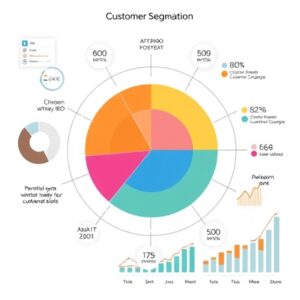Did you know that 80% of companies see more revenue after using customer segmentation? This shows how key it is to master this skill with data analytics tools. We’ll dive into how to use data analytics to unlock new growth chances.
Using Mastering Customer Segmentation with Data Analytics Tools helps businesses understand their audience better. This leads to more effective marketing plans. It’s a vital part of marketing, and with data analytics, it boosts business growth.
We’ll look at different types of customer segmentation. These include demographic, geographic, psychographic, and behavioral. We’ll see how data analytics can improve these strategies. Our aim is to give a detailed guide on mastering customer segmentation with data analytics tools. This will help businesses enhance their marketing and engage customers better.
Key Takeaways
- Mastering customer segmentation with data analytics tools can increase revenue and drive business growth
- Customer segmentation is a crucial aspect of any marketing plan
- Data analytics can be used to enhance customer segmentation strategies
- Demographic, geographic, psychographic, and behavioral segmentation are key types of customer segmentation
- Mastering Customer Segmentation with Data Analytics Tools requires a deep understanding of the target audience
- Customer segmentation can help businesses make data-driven decisions and improve customer engagement

Understanding Customer Segmentation
Customer segmentation is key in today’s marketing world. It helps us divide our customers into groups with similar traits. This way, we can make our marketing more effective, boosting our chances of success.
Studies show that customer segmentation is crucial for any marketing plan. It helps us use our resources better, make customers happier, and grow our sales. With data analytics tools, we can learn more about our customers and create better marketing campaigns.
Good customer data analysis brings many benefits. It gives us better insights, makes our work more efficient, and helps us compete better. Some of these benefits include:
- Improved customer satisfaction
- Increased efficiency in marketing efforts
- Enhanced competitiveness in the market
By knowing what our customers want, we can make marketing that really speaks to them. This drives our business forward. Effective customer segmentation is vital for staying ahead in today’s market. Using data analytics tools and customer data analysis helps us make the most of our marketing.
Types of Customer Segmentation
Customer segmentation is key for any business to succeed. It helps tailor marketing and boost customer happiness. By using data-driven marketing, companies can meet different customer needs. We’ll look at the various types of segmentation and their benefits.
We analyze many factors for segmentation, like demographics, location, lifestyle, and behavior. Demographic segmentation looks at age, income, and job. Geographic segmentation focuses on where customers live. Psychographic segmentation studies lifestyle and values. Behavioral segmentation examines how customers act, like what they buy and browse.
Using these strategies, businesses understand their customers better. This knowledge helps shape marketing and grow the business. Good customer behavior analysis is key for targeted marketing. Data analytics help refine these efforts and boost customer happiness.
- Personalized marketing campaigns
- Improved customer service
- Strategic business planning
- Enhanced customer satisfaction
By focusing on customers and using segmentation, businesses can outdo rivals and grow over time. As we dive deeper into customer segmentation, we’ll see how data analytics and best practices can help.
The Role of Data Analytics in Segmentation
Data analytics is key to better customer segmentation. It helps businesses understand what customers like and do. This way, they can make marketing plans that really work.
Some big pluses of using data analytics in segmentation are:
- Improved customer understanding
- Enhanced targeting and personalization
- Increased efficiency in marketing efforts
How Data Analytics Enhances Segmentation
Data analytics gives businesses a deeper look at their customers. This lets them make marketing plans that really hit the mark. It makes their marketing more effective.

Tools for Data Analysis
There are many tools for analyzing customer data and making segmentation plans. These tools help businesses sort through lots of data. They give insights that help shape marketing strategies.
| Tool | Description |
|---|---|
| Data Mining | Technique used to discover patterns and relationships in large datasets |
| Predictive Analytics | Method used to forecast future customer behavior based on historical data |
| Machine Learning | Artificial intelligence technique used to develop models that predict customer behavior |
Identifying Target Markets
To make a good marketing plan, we need to know our target markets. This means understanding what our ideal customer likes and does. By studying customer behavior analysis, we learn what makes them buy things.
Looking at market trends is also important. We can do this with data-driven marketing. This includes checking sales, website visits, and social media. This way, we can make ads that really speak to our ideal customer.
Here are some ways to find our target markets:
- Do market research to know what customers want and like.
- Look at customer data to spot trends and patterns.
- Make customer personas to help guide our marketing.
By taking these steps and using data-driven marketing, we can find our target markets. Then, we can make marketing plans that really work.
| Target Market Identification Steps | Description |
|---|---|
| Conduct Market Research | Understand customer needs and preferences |
| Analyze Customer Data | Identify trends and patterns |
| Create Customer Personas | Guide marketing efforts |
Collecting and Managing Customer Data
We know how key customer data analysis is for good segmentation strategies. Using data-driven marketing, companies can make campaigns that really speak to their audience. It’s vital to collect and manage customer data well.
Customer data comes from many places, like social media, websites, and feedback. Research shows that customer segmentation analysis is key to knowing your audience. This helps in making marketing that feels personal. But, it’s important to have good data to avoid wrong marketing moves.
To keep data quality high, businesses use tools like CRM systems and DMPs. These help in collecting, storing, and analyzing customer data. This way, companies get insights for better segmentation strategies. By focusing on data quality and using data-driven marketing, businesses can make their marketing more effective.
Analyzing Customer Data
We know how key customer data analysis is for segmentation and marketing. By looking at what customers do, like, and who they are, businesses can tailor their marketing. We aim to explain how to analyze customer data.
Studies show data analysis is key for segmenting customers. It helps businesses understand what customers want and do. This knowledge leads to better marketing, more customer engagement, and loyalty. We’ll explain the methods and tools for analyzing customer data.

Techniques for Data Analysis
Techniques like data mining, predictive analytics, and machine learning are used. They help find patterns in customer data. For example, data mining spots valuable customer groups, and predictive analytics guesses what customers will do next.
Data Visualization Tools
Tools like charts and graphs are essential for sharing insights. They make complex data easy to understand. This helps businesses create marketing that really speaks to their audience.
| Technique | Description |
|---|---|
| Data Mining | Identifying patterns and trends in customer data |
| Predictive Analytics | Forecasting customer behavior and preferences |
| Machine Learning | Developing models to anticipate customer needs |
Using these methods and tools, businesses can craft strong segmentation strategies. This leads to better marketing and more customer loyalty.
Implementing Customer Segmentation Strategies
We know that setting up customer segmentation plans needs careful thought and action. Studies show that a good segmentation plan can really boost marketing efforts. By studying how customers act, we can make ads that really speak to them.
To start, we break down the steps. First, we define target audiences and create customer profiles. Then, we craft ads that fit each group. This way, we can see how well our plans work and tweak them as needed.
Important things to think about when setting up segmentation plans include:
- Doing deep dives into customer behavior to spot trends
- Creating ads that meet each group’s needs and likes
- Keeping an eye on and adjusting our plans for the best results
By using a smart and data-driven way to segment customers, we can find new ways to grow. And we can make our marketing work better.
| Segmentation Strategy | Marketing Goal | Success Metric |
|---|---|---|
| Demographic Segmentation | Increase brand awareness | Engagement metrics (e.g. likes, shares, comments) |
| Behavioral Segmentation | Drive conversions | Conversion rates (e.g. sales, sign-ups) |
Challenges in Customer Segmentation
Implementing customer segmentation strategies can be tough. One big challenge is dealing with data privacy concerns. We must follow rules like GDPR and CCPA when we collect and analyze customer data.
Another challenge is getting people to accept change. We need to show our team how customer segmentation helps. By training and supporting them, we can use data to make our marketing better and please our customers more.
Some common mistakes to avoid in customer segmentation include:
- Relying too heavily on demographics
- Failing to consider customer preferences
- Not regularly updating customer data
By knowing these challenges and working to solve them, we can make the most of customer segmentation. This can help our business grow.
| Challenge | Solution |
|---|---|
| Data privacy concerns | Ensure compliance with regulations such as GDPR and CCPA |
| Resistance to change | Communicate benefits and provide training and support |
| Common pitfalls | Avoid relying on demographics, consider customer preferences, and regularly update customer data |
Case Studies and Real-World Examples
Customer segmentation is a powerful tool for businesses. Now, let’s look at some real-world examples. Companies like Amazon and Netflix have used data analytics to understand their customers better. This helps them create targeted marketing and improve customer satisfaction.
These companies have analyzed customer data to find specific groups. Amazon offers personalized product recommendations. Netflix suggests TV shows and movies based on what you’ve watched before.
Here are some key lessons from these examples:
- It’s important to keep monitoring and improving your segmentation strategies.
- Using data analytics tools is crucial to understand customer behavior and preferences.
- Creating targeted marketing campaigns for specific customer segments is very valuable.
By learning from these examples, businesses can grow, improve customer satisfaction, and stay ahead in the market.
 Trends in Customer Segmentation
Trends in Customer Segmentation
The world ofcustomer segmentationis set for a big change. This change comes from newdata analytics toolsand technologies. Artificial intelligence (AI) and machine learning are changing how businesses usecustomer data analysis.
These tools help businesses understand their customers better. They can predict what customers will want and need. This lets companies create marketing plans that really speak to their audience.
Looking ahead, it’s important for companies to keep up. They need to invest in the bestdata analytics tools. They also need to make decisions based on data. This way, they can use the latest trends to their advantage.
